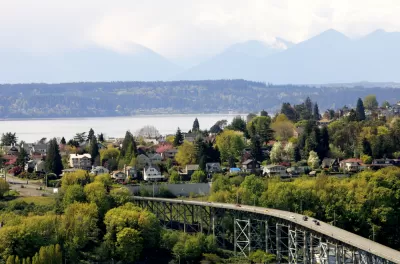Seattle's suburbs are no longer leading the region in housing construction, even as Seattle's urban core is building more housing than ever.

Mike Rosenberg reports on the regional housing market in Seattle, where suburban housing construction has slowed considerably, especially compared to the record-setting pace of building taking place in the more urban, central areas of the region.
The region's suburbs are no longer producing housing at a rate commensurate with the suburban share of the region's population. "Overall, Seattle housing construction has grown 130 percent this decade compared to the average over the prior three decades, while housing development in the suburbs has dropped 43 percent from its historical average," reports Rosenberg. The decline of suburban housing means housing production is declining for the region as a whole—that despite steady development in Seattle producing what some are describing as a glut in the rental market.
"The shift is the result of a combination of developers chasing the biggest profits in Seattle – where housing demand has gone through the roof, and city leaders have opened the floodgates for bigger buildings – and suburbs restricting new construction through zoning laws that all but ban new housing in most parts of the region," according to Rosenberg.
The feature-length coverage of the regional landscape for housing development includes a lot of data visualizations and additional means of putting the suburban housing slow down in perspective.
FULL STORY: Housing construction in local suburbs is at historic lows, while Seattle is setting records

Maui's Vacation Rental Debate Turns Ugly
Verbal attacks, misinformation campaigns and fistfights plague a high-stakes debate to convert thousands of vacation rentals into long-term housing.

Planetizen Federal Action Tracker
A weekly monitor of how Trump’s orders and actions are impacting planners and planning in America.

Chicago’s Ghost Rails
Just beneath the surface of the modern city lie the remnants of its expansive early 20th-century streetcar system.

Bend, Oregon Zoning Reforms Prioritize Small-Scale Housing
The city altered its zoning code to allow multi-family housing and eliminated parking mandates citywide.

Amtrak Cutting Jobs, Funding to High-Speed Rail
The agency plans to cut 10 percent of its workforce and has confirmed it will not fund new high-speed rail projects.

LA Denies Basic Services to Unhoused Residents
The city has repeatedly failed to respond to requests for trash pickup at encampment sites, and eliminated a program that provided mobile showers and toilets.
Urban Design for Planners 1: Software Tools
This six-course series explores essential urban design concepts using open source software and equips planners with the tools they need to participate fully in the urban design process.
Planning for Universal Design
Learn the tools for implementing Universal Design in planning regulations.
planning NEXT
Appalachian Highlands Housing Partners
Mpact (founded as Rail~Volution)
City of Camden Redevelopment Agency
City of Astoria
City of Portland
City of Laramie





























